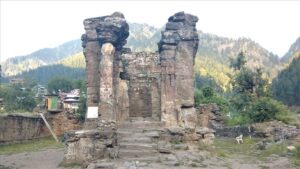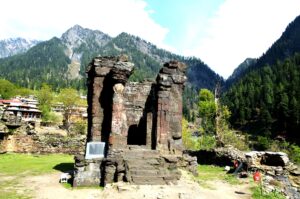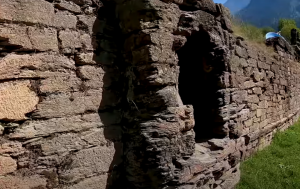Neelum Valley, Azad Jammu & Kashmir🇵🇰– Perched on a hillock along the left bank of the Neelum River, the ancient Sharada Peeth temple stands as a silent witness to over a thousand years of Kashmiri heritage, Hindu spirituality, and scholarly excellence. Once a beacon of learning and a sacred pilgrimage site, this monument—now in ruins—holds within its weathered stones the echoes of a glorious past and the tragic story of neglect.
A Legacy Carved in Stone: Origins and Significance
Sharada Peeth, also known as Sharda Peeth, is dedicated to Goddess Sharada (a form of Saraswati), the Hindu deity of knowledge, wisdom, and the arts. The name itself means the “Seat of Sharada”, reflecting its dual role as a spiritual sanctuary and a center of intellectual pursuit.
The Birth of a Sacred Site
While the of Sharada Peeth remain debated, archaeologists and historians generally place its establishment between the 7th and 8th centuries CE. Located in Tehsil Sharda of the Neelum District, approximately 104 kilometers from Muzaffarabad, the temple became a cornerstone of Kashmiri identity and Hindu religious tradition.
In ancient Sanskrit and Kashmiri texts, Sharada Peeth is revered as a sacred abode of learning, a place where scholars, philosophers, and seekers gathered to exchange knowledge. The site is so deeply intertwined with the region’s cultural fabric that Kashmir itself was sometimes called “Sharada Desh” (the Land of Sharada).
Sharada Peeth: The “University” of the Himalayas
For centuries, Sharada Peeth was more than just a temple- it was a vibrant hub of education, often romanticized in local lore as “Sharda University.” While it may not have been a formal institution like Nalanda or Taxila, historical accounts and scholarly traditions suggest it functioned as a premier center of learning.
A Sanctuary of Knowledge
Students and scholars from distant regions traveled to Sharada Peeth to study:
- Philosophy and religion
- Astrology and astronomy
- Sanskrit literature and grammar
- The arts and sciences
The temple’s legendary library was a treasure trove of manuscripts and texts, many written in the —a writing system that originated here and was used across Kashmir and parts of Central Asia. The site became a cradle of intellectual debate, where ideas were preserved, challenged, and refined.
Debating the “University” Label
While some historians argue that Sharada Peeth was not a university in the modern sense, others emphasize its role in fostering higher learning. The truth likely lies somewhere in between: it was a spiritual and academic sanctuary, where knowledge was sacred, and teaching was a divine duty.
Architecture: A Masterpiece of Ancient Craftsmanship
Sharada Peeth’s architectural grandeur reflects the artistic and engineering prowess of its time. Built on a hillock, the temple is accessed by 63 stone-slab stairs, leading visitors to a structure that once inspired awe.
Design and Materials
The temple was constructed using:
- Red sandstone
- Local granite
- Marble accents
Its design shares similarities with other Kashmiri temples, such as the Martand Sun Temple and Avantipur Temple, particularly in the use of stone slabs for structural integrity. Key features included:
- A , a rarity in temple architecture of the time.
- An enclosure with surviving walls.
- Niches for lamps and ritual items, carved into the stone.
By the late 19th century, the temple’s roof had collapsed, and temporary wooden structures were occasionally erected to protect what remained. Today, floods, erosion, and neglect have further damaged the site, leaving only fragments of its former glory.
Decline and Rediscovery: A Monument in Ruins
By the time British surveyors like Charles Ellison Bates visited in 1873, Sharada Peeth was already a shadow of its former self. Bates described a roofless, crumbling structure, its grandeur reduced to ruins. Over the centuries, natural disasters, political conflicts, and apathy accelerated its decay.
The Challenges of Preservation
Sharada Peeth’s location near the —the de facto border between India and Pakistan—has made conservation efforts difficult. Despite its protected monument status under the laws of Azad Jammu & Kashmir, the temple faces:
- Weathering and erosion from harsh Himalayan conditions.
- Limited access due to geopolitical tensions.
- Insufficient funding for restoration and maintenance.
Recent archaeological surveys and have documented the site and recovered artefacts, but much remains to be done to preserve this irreplaceable heritage.
Cultural and Religious Significance: A Pilgrimage of the Soul
For and Hindus worldwide, Sharada Peeth is a sacred pilgrimage site, believed by some to be one of the —holy seats dedicated to the Divine Feminine. The temple’s spiritual aura is amplified by its stunning natural surroundings, nestled in the lush Neelum Valley, where the Neelum River flows with an almost mythical serenity.
A Symbol of Identity and Faith
The temple is not just a physical structure; it is a symbol of Kashmiri Hindu identity and a testament to the region’s rich cultural tapestry. For centuries, it has been a source of inspiration for poets, scholars, and devotees, who see it as a bridge between the earthly and the divine.
The Dream of Revival
There have been calls to reopen pilgrimage routes to Sharada Peeth, allowing devotees to reconnect with their heritage. However, political tensions and logistical challenges have kept this dream just out of reach. If realized, such a move could revitalize cultural tourism and foster cross-border dialogue on shared heritage.
Myths, Legends, and the Spirit of Sharada
Sharada Peeth is steeped in myth and legend, adding to its mystique and allure.
The Goddess and the Script
Local traditions claim that Goddess Sharada herself blessed this land, making it a sanctuary of wisdom. The Sharada script, which flourished here, became one of the most important writing systems in medieval Kashmir and Central Asia, used for Sanskrit manuscripts and royal decrees.
Visits by Great Scholars
Some sources suggest that renowned scholars and saints, including , visited Sharada Peeth for spiritual debates and discourses. While conclusive evidence is scarce, these stories enrich the temple’s legacy, painting it as a meeting place of great minds.
The Path Forward: Preserving a Legacy
Sharada Peeth is more than just an ancient ruin- it is a living symbol of Kashmir’s intellectual and spiritual heritage. To honor its legacy, concerted efforts are needed:
✅ Comprehensive restoration to stabilize the remaining structure. ✅ Archaeological research to uncover more about its history. ✅ to facilitate pilgrimage and tourism. ✅ Awareness campaigns to highlight its cultural significance. ✅ Government and NGO funding to ensure long-term preservation.
Conclusion: A Call to Remember
Sharada Peeth stands as a poignant reminder of what was lost—and what could be reclaimed. It is a testament to the enduring power of knowledge, faith, and culture, even in the face of time and neglect.
As we reflect on its glorious past and uncertain future, one question remains: Will we let this beacon of wisdom fade into obscurity, or will we rise to preserve it for generations to come?
Sharada Peeth is not just a temple—it is a legacy. And legacies deserve to be remembered.




Have you heard of Sharada Peeth? What do you think should be done to preserve such historical treasures? Share your thoughts below. 🏔️🕉️ #SharadaPeeth #KashmirHeritage #AncientWisdom






